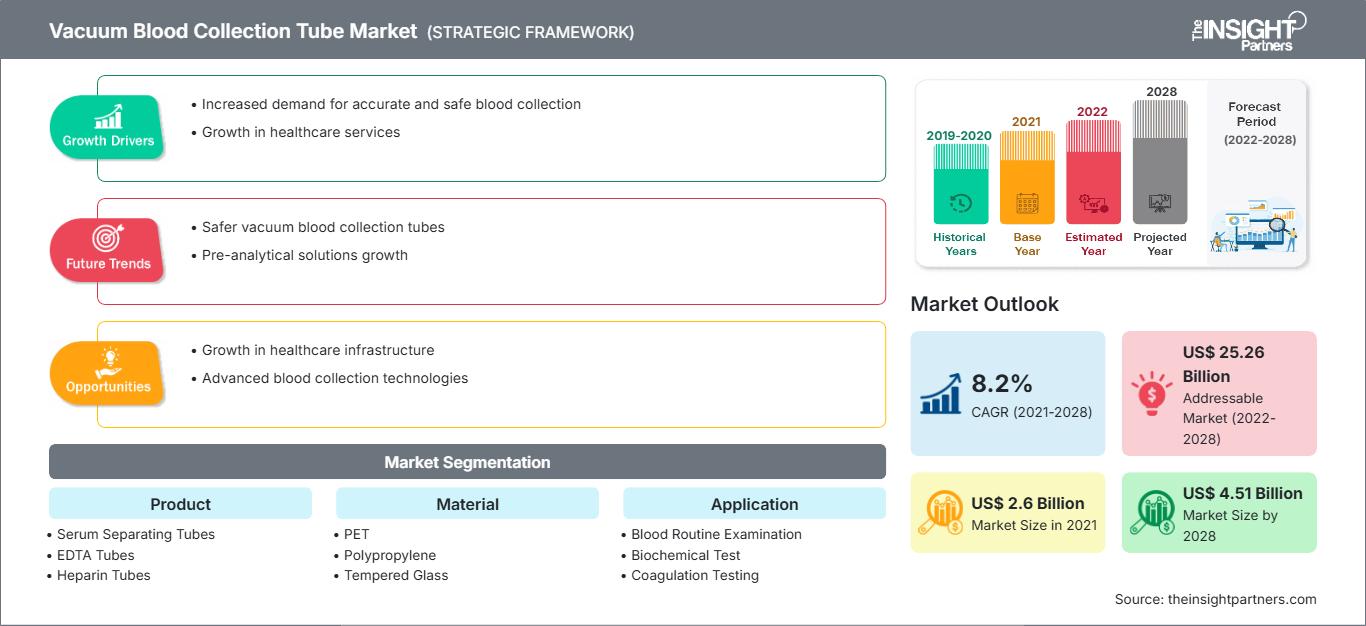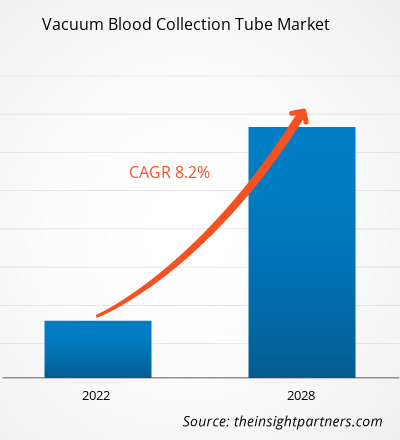Der Markt für Vakuum-Blutentnahmeröhrchen soll von 2.598,78 Millionen US-Dollar im Jahr 2021 auf 4.507,70 Millionen US-Dollar im Jahr 2028 anwachsen; das Wachstum wird von 2021 bis 2028 auf durchschnittlich 8,2 % geschätzt.
Ein Vakuum-Blutentnahmeröhrchen ist ein steriles Reagenzglas aus Glas oder Kunststoff mit einem Stopfen, der im Inneren des Röhrchens ein Vakuum erzeugt, sodass eine voreingestellte Flüssigkeitsmenge entnommen werden kann. Das Röhrchen verhindert Nadelstichverletzungen, indem es den menschlichen Kontakt mit den Nadeln und damit deren Verfälschung verhindert. Eine doppelspitzige Nadel ist an einem röhrenförmigen Kunststoffadapter im Vakuum-Blutentnahmeröhrchen befestigt. Doppelspitzige Nadeln sind in zahlreichen Stärken erhältlich. Die Nadellänge variiert zwischen 1 und 1 1/2 Zoll. Vakuum-Blutentnahmeröhrchen können zusätzliche Elemente enthalten, die zur Konservierung von Blut für die Behandlung in medizinischen Labors verwendet werden. Die zunehmende Zahl staatlicher Subventionen und Gesundheitsdienste dürfte das Marktwachstum in den kommenden Jahren vorantreiben. Darüber hinaus wird erwartet, dass das steigende Bewusstsein für die Vorteile der Sterilisation in Industrie- und Schwellenländern im Prognosezeitraum erhebliche Wachstumschancen auf dem Markt bietet.
Der Markt für Vakuum-Blutentnahmeröhrchen ist regional in Nordamerika, Europa, Asien-Pazifik (APAC), Naher Osten und Afrika (MEA) sowie Süd- und Mittelamerika (SAM) unterteilt. Nordamerika dominiert den Weltmarkt aufgrund von Faktoren wie günstigen Regierungsprogrammen und -initiativen für Blutspenden, einem verbesserten öffentlichen Bewusstsein, der Zunahme chronischer Krankheiten, verstärkten Forschungs- und Entwicklungsaktivitäten der wichtigsten Akteure und Fortschritten bei Vakuum-Blutentnahmeröhrchen.
Passen Sie diesen Bericht Ihren Anforderungen an
Sie erhalten kostenlos Anpassungen an jedem Bericht, einschließlich Teilen dieses Berichts oder einer Analyse auf Länderebene, eines Excel-Datenpakets sowie tolle Angebote und Rabatte für Start-ups und Universitäten.
Markt für Vakuum-Blutentnahmeröhrchen: Strategische Einblicke

-
Holen Sie sich die wichtigsten Markttrends aus diesem Bericht.Dieses KOSTENLOSE Beispiel umfasst Datenanalysen, die von Markttrends bis hin zu Schätzungen und Prognosen reichen.
Markteinblicke
Steigende Anzahl von Operationen
Mit der Zunahme von Herz-, Leber-, Nieren-, Lungen- und anderen chronischen Erkrankungen hat auch die Zahl der jährlich durchgeführten Operationen deutlich zugenommen. Laut dem National Chronic Kidney Disease Fact Sheet litten im Jahr 2017 in den USA etwa 30 Millionen Menschen an chronischen Nierenerkrankungen. Darüber hinaus leiden laut dem National Institute of Diabetes and Digestive and Kidney Diseases etwa 661.000 Amerikaner an Nierenversagen, von denen sich 468.000 Patienten einer Dialyse unterziehen und 193.000 eine Nierentransplantation erhalten haben. Ebenso wurden laut dem siebten Jahresbericht des American Joint Replacement Registry (AJRR) zur Knie- und Hüftarthroplastik im Zeitraum 2019–2020 etwa 2 Millionen Hüft- und Knieoperationen durchgeführt. Die Daten stammen von 1.347 Einrichtungen aus Krankenhäusern, ambulanten Operationszentren (ASCs) und privaten Arztpraxen in allen 50 Bundesstaaten der USA und dem District of Columbia. Angioplastie und Atherektomie gehören zu den in den USA am häufigsten durchgeführten Operationen. Laut der jüngsten Verfahrensanalyse der interventionellen Kardiologie werden beispielsweise in den USA jedes Jahr mehr als 965.000 Angioplastien durchgeführt. Eine Angioplastie, auch als perkutane Koronarintervention (PCI) bezeichnet, ist ein chirurgischer Eingriff, bei dem ein Stent in eine verstopfte oder verengte Arterie eingesetzt wird.
Ein weiterer wichtiger Grund für die steigende Zahl von Operationen ist die wachsende Zahl von Unfällen und Traumata. Die steigende Zahl von Verkehrsunfällen, Bränden und Sportverletzungen hat zu einer erhöhten Zahl von Traumata und Verletzungen geführt. Laut dem Global Status Report on Road Safety – einem 2018 von der Weltgesundheitsorganisation (WHO) veröffentlichten Bericht – sind Verkehrsunfälle eine der häufigsten Todesursachen weltweit. Jährlich sterben etwa 1,3 Milliarden Menschen bei Verkehrsunfällen. Aktuelle Trendanalysen sagen voraus, dass Verkehrsunfälle bis 2030 weltweit die fünfthäufigste Todesursache sein werden.
Die steigende Zahl von Unfällen und Verletzungen wird den Bedarf an Bluttransfusionen in den kommenden Jahren ankurbeln. Unfallopfer oder Traumapatienten erleiden häufig Blutverlust. Daher ist eine Bluttransfusion, insbesondere von roten Blutkörperchen, erforderlich, um das verlorene Blutvolumen wiederherzustellen. Der Bedarf an Bluttransfusionen bei Traumapatienten wird zusammen mit der steigenden Zahl von Verletzungen das Wachstum des Marktes für Blutentnahmegeräte ankurbeln. Mit diesem alarmierenden Anstieg der Operationen und Bluttransfusionen steigt der Bedarf an Geräten zur Blutentnahme, was die Nachfrage nach Vakuum-Blutentnahmeröhrchen stark erhöht und dem nordamerikanischen Markt für Vakuum-Blutentnahmeröhrchen einen deutlichen Schub verleiht.
Produktbasierte Erkenntnisse
Der globale Markt für Vakuum-Blutentnahmeröhrchen ist nach Produkten unterteilt in Heparinröhrchen, EDTA-Röhrchen, Glukoseröhrchen, Serumtrennröhrchen und ERS-Röhrchen. Im Jahr 2021 hatte das Segment der Serumtrennröhrchen den größten Marktanteil. Darüber hinaus wird erwartet, dass der Markt für das Segment der EDTA-Röhrchen in den kommenden Jahren am schnellsten wachsen wird.
Materialbasierte Erkenntnisse
Der globale Markt für Vakuum-Blutentnahmeröhrchen ist nach Materialien unterteilt in PET, Polypropylen und gehärtetes Glas. Im Jahr 2021 hatte das Segment PET den größten Marktanteil. Darüber hinaus wird erwartet, dass der Markt für dieses Segment in den kommenden Jahren am schnellsten wachsen wird.
Anwendungsbasierte Erkenntnisse
Der globale Markt für Vakuum-Blutentnahmeröhrchen ist nach Anwendung in die Bereiche Routineblutuntersuchung, biochemische Tests und Gerinnungstests unterteilt. Im Jahr 2021 hatte das Segment Routineblutuntersuchung den größten Marktanteil. Es wird jedoch erwartet, dass der Markt für Gerinnungstests in den kommenden Jahren am schnellsten wachsen wird.
Endnutzerbasierte Erkenntnisse
Basierend auf dem Endnutzer ist der Markt für Vakuum-Blutentnahmeröhrchen in Krankenhäuser und Kliniken, ambulante chirurgische Zentren, Pathologielabore und Blutbanken unterteilt. Das Segment Blutbanken hatte 2021 den größten Marktanteil. Darüber hinaus wird für dasselbe Segment im Prognosezeitraum die höchste durchschnittliche jährliche Wachstumsrate (CAGR) von 8,8 % erwartet.
Die Akteure auf dem Markt für Vakuum-Blutentnahmeröhrchen verfolgen organische Strategien wie Produkteinführung und -erweiterung, um ihre Präsenz und ihr Produktportfolio weltweit zu erweitern und die wachsende Nachfrage zu befriedigen.
Auswirkungen von COVID
Die nordamerikanische Wirtschaft ist aufgrund des exponentiellen Wachstums der COVID-19-Fälle in der Region stark betroffen. Es wird erwartet, dass die COVID-19-Pandemie unmerklich negative Auswirkungen auf den Markt haben wird. Die COVID-19-Pandemie und der darauffolgende wirtschaftliche Abschwung haben sich nachteilig auf das psychische Wohlbefinden der Menschen ausgewirkt und neue Barrieren für diejenigen aufgebaut, die bereits an einer psychischen Erkrankung oder Verhaltensstörungen leiden. Etwa 4 von 10 Erwachsenen in den USA haben während der Pandemie von Anzeichen einer Angststörung oder Depression berichtet. Diese Zahl ist weitgehend stabil geblieben, während von Januar bis Juni 2019 nur jeder zehnte Erwachsene entsprechende Symptome hatte. Laut der KFF Health Tracking Poll vom Juli 2020 berichten viele Erwachsene von konkreten negativen Auswirkungen auf ihre psychische Gesundheit und ihr Wohlbefinden infolge von Sorgen und Stress im Zusammenhang mit dem Coronavirus, wie Schlafstörungen (36 %), Essstörungen (32 %), erhöhter Alkohol- oder Substanzkonsum (12 %) und eine Verschlechterung chronischer Erkrankungen (12 %). Mit dem Fortschreiten der Epidemie setzen die fortgesetzten und erforderlichen Maßnahmen des öffentlichen Gesundheitswesens viele Menschen Szenarien aus, die mit negativen Auswirkungen auf die psychische Gesundheit verbunden sind, wie Isolation und Arbeitsplatzverlust.
Vakuum-Blutentnahmeröhrchen
Regionale Einblicke in den Markt für Vakuum-BlutentnahmeröhrchenDie Analysten von The Insight Partners haben die regionalen Trends und Faktoren, die den Markt für Vakuum-Blutentnahmeröhrchen im Prognosezeitraum beeinflussen, ausführlich erläutert. In diesem Abschnitt werden auch die Marktsegmente und die geografische Lage von Vakuum-Blutentnahmeröhrchen in Nordamerika, Europa, im asiatisch-pazifischen Raum, im Nahen Osten und Afrika sowie in Süd- und Mittelamerika erörtert.
Umfang des Marktberichts zu Vakuum-Blutentnahmeröhrchen
| Berichtsattribut | Einzelheiten |
|---|---|
| Marktgröße in 2021 | US$ 2.6 Billion |
| Marktgröße nach 2028 | US$ 4.51 Billion |
| Globale CAGR (2021 - 2028) | 8.2% |
| Historische Daten | 2019-2020 |
| Prognosezeitraum | 2022-2028 |
| Abgedeckte Segmente |
By Produkt
|
| Abgedeckte Regionen und Länder |
Nordamerika
|
| Marktführer und wichtige Unternehmensprofile |
|
Marktdichte von Vakuum-Blutentnahmeröhrchen: Einfluss auf die Geschäftsdynamik verstehen
Der Markt für Vakuum-Blutentnahmeröhrchen wächst rasant. Dies ist auf die steigende Nachfrage der Endverbraucher zurückzuführen, die auf Faktoren wie veränderte Verbraucherpräferenzen, technologische Fortschritte und ein stärkeres Bewusstsein für die Produktvorteile zurückzuführen ist. Mit der steigenden Nachfrage erweitern Unternehmen ihr Angebot, entwickeln Innovationen, um den Bedürfnissen der Verbraucher gerecht zu werden, und nutzen neue Trends, was das Marktwachstum weiter ankurbelt.

- Holen Sie sich die Markt für Vakuum-Blutentnahmeröhrchen Übersicht der wichtigsten Akteure
Nach Produkt
- Gel- und Gerinnungsaktivatorröhrchen
- Heparinröhrchen
- EDTA-Röhrchen
- Glukoseröhrchen
- Serumtrennröhrchen
- ERS-Röhrchen
Nach Material
- PET
- Polypropylen
- Gehärtetes Glas
Nach Anwendung
- Routinemäßige Blutuntersuchung
- Biochemischer Test
- Gerinnungstests
Nach Endbenutzer
- Krankenhäuser und Kliniken
- Ambulante chirurgische Zentren
- Pathologie Labore
- Blutbanken
Nach
Geographie
- Norden Amerika
- USA
- Kanada
- Mexiko
- FrankreichKorea
- Japan
- Australien
- Rest von APAC
- Naher Osten und Asien Afrika (MEA)
- Südafrika
- Saudi-Arabien
- VAE
- Rest von MEA
- Süd- und Mittelamerika (SCAM)
- Brasilien
- Argentinien
- Rest von SCAM
Firmenprofile
- BD
- Narang Medical Limited
- Terumo Corporation
- GPC Medical Ltd.
- Vitrex Medical A/S
- Medtronic
- KALSTEIN FRANCE
- ELITech Group
- FL Medical
- STRECK, INC.
- Historische Analyse (2 Jahre), Basisjahr, Prognose (7 Jahre) mit CAGR
- PEST- und SWOT-Analyse
- Marktgröße Wert/Volumen – Global, Regional, Land
- Branchen- und Wettbewerbslandschaft
- Excel-Datensatz
Aktuelle Berichte
Verwandte Berichte
Erfahrungsberichte
Grund zum Kauf
- Fundierte Entscheidungsfindung
- Marktdynamik verstehen
- Wettbewerbsanalyse
- Kundeneinblicke
- Marktprognosen
- Risikominimierung
- Strategische Planung
- Investitionsbegründung
- Identifizierung neuer Märkte
- Verbesserung von Marketingstrategien
- Steigerung der Betriebseffizienz
- Anpassung an regulatorische Trends






















 Kostenlose Probe anfordern für - Markt für Vakuum-Blutentnahmeröhrchen
Kostenlose Probe anfordern für - Markt für Vakuum-Blutentnahmeröhrchen